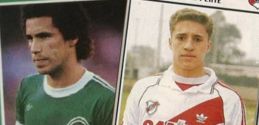A guide to the 2011 Copa America: Part Two – The Outsiders, Mexico & Costa Rica
Introducing the second part of David N’s guide to the Copa America.
Two guest nations have been invited to every Copa America since 1993. They have included the USA, Honduras, Japan and Canada (who withdrew, alongside Argentina, in 2001 due to security concerns about host nation Colombia). So, these two Nations are literally outsiders, in that neither is from South America, though they are both Spanish-speaking countries, keeping this year’s tournament an all-Latin affair:
MEXICO
The big problem for Mexico with the Copa America is that it follows so hot on the heels of the tournament of their own Confederation. CONCACAF, which governs football in North and Central America together with the Caribbean, is holding the Gold Cup in the US this month, and Mexico, who are holders, having won the tournament in 2009, will be vying with the likes of the USA, Honduras and Costa Rica to keep their title. That fact, together with CONCACAF rules concerning participation in tournaments organised by other confederations, means that Mexico are sending what is effectively an Under-22 team to Argentina for the Copa America. The Mexican squad, much like an Olympic football squad, is bolstered by five senior players, four of whom were in the senior squad for the 2010 World Cup. Further complicating matters is the Under-20 World Cup, which begins in Colombia five days after the Copa America ends, and will presumably deprive the Mexicans of a couple of extremely talented youngsters who might otherwise have featured heavily at the Copa, such as Chivas’ exciting striker Erik “Cubo” Torres (Javier Hernandez’s replacement in Guadalajara) and Diego Reyes of Club America. Both players are in the provisional squad but may well be cut when it is whittled down to 22, or brought to the tournament but used sparingly.
This is still a relatively strong Mexican squad, with players from all of Mexico’s biggest clubs. The Mexican league is one of the deepest in Latin America, financially healthy, massively popular and consistently competitive, and its big clubs produce a steady stream of young talent. Young Mexican players rarely go abroad the way young Argentines do, because they do not need to, since their own clubs can afford to keep and develop them.
You could argue that Mexico have underachieved internationally. Though they have qualified for every World Cup since 1994 and consistently get to the Round of 16, they have yet to go any further. Once they meet any of the major powers (Argentina in each of the last two tournaments) they are eliminated. They have won the Gold Cup an impressive eight times, were runners-up in the Copa America twice -1993 and 2001 - and triumphed in the 1999 Confederations Cup, beating Brazil 4-3 in the final, but such a passionate, populous football nation could and perhaps should be contenders for the World Cup itself. The generation of youngsters breaking through into the national team at the moment - led by Hernandez - may be capable of challenging for such a prize, and more players moving to Europe and playing in a competition like the Champions League can only help them.
The two Europe-based players named in the preliminary Copa America squad are Arsenal’s Carlos Vela and Barcelona’s Jonathan Dos Santos (younger brother of Giovanni, left). Vela is more important for Mexico than he is for his club, but Arsenal refused permission for him to play in the tournament this year. His replacement in the starting line-up will likely be one of the five senior players, Rafael Márquez Lugo (top), a prolific, stocky little striker. Dos Santos, meanwhile, is a central midfielder with metronomic passing ability and the vision and patience to dictate the pattern of a game. All he really lacks is an eye for goal, but he strikes the ball so well that it might just be a matter of how he is instructed to play by his club, Barcelona B.
Under Coach Jose Manuel “Chepo” de la Torre Menchaca, Mexico’s first team play a 4-2-3-1 based on fluid interplay and sweeping passing moves, and the Copa America side will probably do the same. Certainly the involvement of players like Dos Santos and wingers Edgar Iván Pacheco and Néstor Calderón give them the technical proficiency to do so. Jonny Magallón, a veteran of the national team for a decade or so, should provide experience and leadership in defence.
Though this side is a touch experimental, Mexico are generally competitive and I can see them surprising some in Argentina. They are, however, in perhaps the toughest and most evenly competitive group, Group C, alongside Uruguay, Chile and Peru, which might limit their chances of progression.
Pacheco shines and scores in a 2-0 friendly win against Bosnia, 9 February 2011.
COSTA RICA
Japan were originally invited to be the second guest nation at this tournament, but the effects of the devastating earthquake and tsunami on the country in March mean that they pulled out and Costa Rica were invited in their stead. The Ticos have played at the tournament three times before, in 1997, 2001 and 2004, reaching the Quarter-Finals on the last two occasions. They too share the Gold Cup problem with Mexico, but have found an interesting way to maintain squad continuity and spirit. The senior squad selected for the Gold Cup (captained by Bryan Ruiz of FC Twente, probably Costa Rica’s most famous active player) and the Under-22 squad who will play at the Copa America will travel to the US as a group, training and playing practice games together. A few players may feature in both competitions.
Historically Costa Rica punch slightly above their weight, having qualified for three World Cups and bloodied some noses along the way - a 1-0 win over a strong Scotland side in Genoa in 1990 stands out - and also with three Gold Cup wins, making them CONCACAF’s third most successful side behind Mexico and the USA.
Argentine Ricardo La Volpe is currently coach, having led Mexico to the 2006 World Cup and managed Boca Juniors, Velez Sarsfield and a half dozen Mexican clubs in his career. He likes to set his teams up in a 5-3-2, utilising Brazilian-style wing backs, which in effect makes them 3-2-3-2 while in possession and vulnerable to balls played into space down the flanks behind those advanced full backs. Such a strategy may be risky with a young squad, since they face hosts Argentina and Colombia, together with Bolivia in their group. Advancing from the group may not be beyond them, however. The competition seems structured to guarantee that the stronger nations can survive the odd surprise result. There are three groups of four teams each, with the first and second placed teams from each group qualifying automatically for the Quarter-finals. They are joined by the two best performing third placed teams, meaning that of the 12 competing sides, only four will not advance from the group to the knockout stage of the competition. This effectively means that if Costa Rica can beat Bolivia, say, then they could make the Quarters, even if they lose to both Argentina and Colombia.
The squad is a cosmopolitan mix of players at Costa Rican clubs and those who ply their trade abroad. The likes of strikers Diego Madrigal (right) of Paraguayan Copa Libertadores Semi-finalists Cerro Porteno and Marcos Urena of the Russian Kuban Krasnodar may well feature, alongside Diego Estrada (above), an exciting attacking midfielder who has been the key player for his country’s youth teams at various tournaments over the last few years. However, with so little time to plan or prepare for such a big tournament, it’s perhaps silly to expect too much from this Costa Rica side. But then many said the same about Denmark going into the European Championships in 1992, and look how that turned out…
Madrigal scores in a 1-0 friendly win over Nigeria, 29 May 2011.
More of David N’s musings on football from South America and beyond can be found on GolGolGolGolGol and also on his Twitter page.
Tags:Share this article
Leave a comment
- Swansea City defender Alan Tate learns the dangers of golf and other perilous stories of salad cream, watching TV and getting married
- Guess the Premier League import from their classic football sticker
- Neil Warnock unleashes a bollocking, QPR players beware – Huddersfield vs. Shrewsbury 1994/95
- When Alex Sabella joined Sheffield United
- In defence of Newcastle midfielder Joey Barton
- Two Rabona goals this season – Introducing Matias Urbano
- The view from the comfy seats of Arsenal’s discontent
- Player Profile: Dejan Petković
- Guess the Copa America star from their classic football sticker
- A guide to the 2011 Copa America: Part Six – The Giants, Argentina and Brazil















Comments